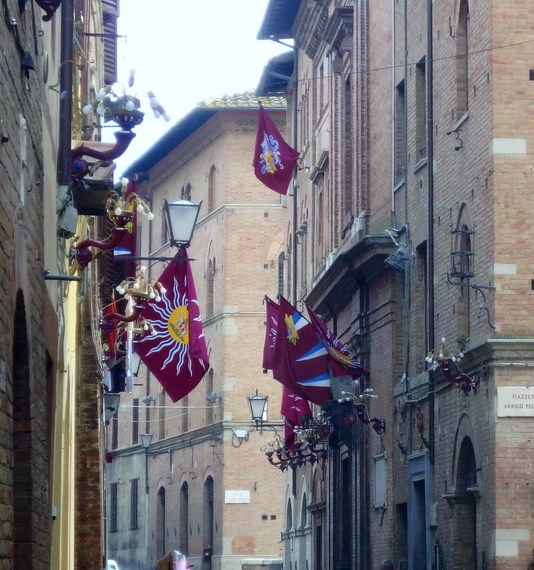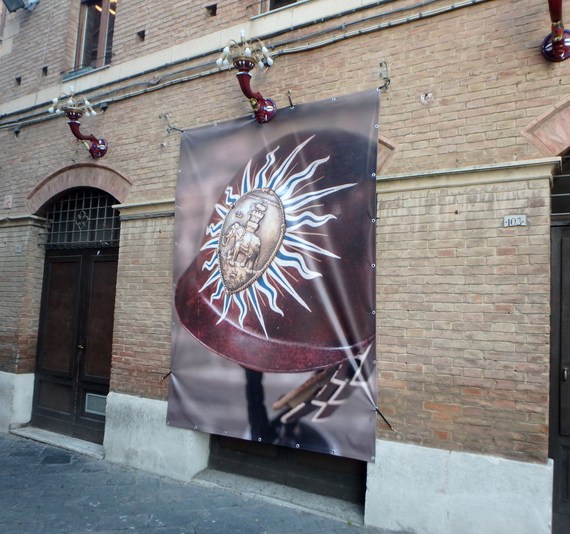Last week, the organizers of The Palio, Siena's famous horse race, declined an invitation to appear in a parade for Queen Elizabeth's 90th birthday, basically saying the parade might misrepresent the prestige of the historical and traditional event.
I recently wrote about the Palio on my blog to explain the passion and tradition that the Senese have for the race. Below is the post, edited for space.
Mauro Faleri was 18 years old the first time he participated in the "Passegiata storica," the ceremony before the start of The Palio, the historic horse race held twice a year in Siena. He is a member of the Torre contrada, or neighborhood. "I was very proud," he tells me. "It was fantastic. It was an honor to represent my contrada."
For outsiders, it's difficult to understand the passion, the lifelong dedication to a contrada that exists in Siena, and the importance of the Palio itself. You get a sense of it every July 2 and August 16, when the Palio is run. But it's also a part of the very being of a Siena native, or Senese.
I was one of those outsiders during the six weeks I spent in Siena, studying at the Saena Iulia language school. I learned about the tradition, the rituals and which contrade are rivals. There are some people who will take a long way around to wherever their going just to avoid walking through a rival's contrada. Or so I've heard. (I love that).
As a member of a contrada, Senese wear a fazzoletto (a scarf of their contrada) proudly around their shoulders during the days of the Palio and only if their contrada is in it. Those in the processions wave their flags with precision in every ceremony celebrating the contrade and the city. There are ceremonies throughout the year, as I witnessed on Dec. 1, the Feast of Sant'Ansano.
"The Palio offers a way to be part of the community. It's a way to fill your life," Mauro says. Torre won the July 2 Palio last summer, the first time since 1896 that they've won the July race. A victory in the Palio is, indeed, very emotional. There's no second or third place. It's win or nothing. "I've seen Italy win the World Cup . . . There's nothing like the victory of your contrada in the Palio," Mauro says. "This year was special."
Pride on display in the Torre contrada.
The last time Torre won was the August 16 race in 2005. Mauro waxes poetic about that day. "I couldn't believe I was in the middle of this. I'd been dreaming of this, imagining this, to be here in the middle of all these people." The previous victory was also the August race in 1961.
Two of my fellow Saena Iulia students, Daniela and Thomas, were in Siena this summer for the July race and were with Mauro when Torre won.
"It was an extraordinary and gigantic spectacle," Daniela says. While waiting for the race to start in the Piazza, she says you could just sense the emotion and the tension starting to build. Everyone was feeling it. And despite being in the packed Piazza with thousands of people, it wasn't ever dangerous, she said.
Finally the horses were off and everyone started cheering. When Torre won, the contrada members, including our dear friend Mauro, started their raucous celebration immediately, jumping up and down, hooting and hollering, as one would expect. Think World Series Game 7, bottom of the ninth, two-out, game-winning hit. "Madonna, these Senese are crazy!" Daniela says with a big smile. "But it was wonderful and I would like to go again."
The Palio has been held twice a year since the 1600s in Piazza del Campo. Before then, it was held on other dates and the course went through the city. It started as a military exercise and has remained a tradition ever since. Ten of the 17 contrade participate in the race. The seven contrade that don't participate in that year's race compete automatically the next year. The remaining three spots are drawn by a lottery. Every year, there's a contrada that will compete in both races or in neither.
The day of the race is a culmination of four days steeped in traditions, including the selection of the horse for each contrada, done by a drawing. The horses go through six trial runs in the Piazza, for practice, to get them used to the course, a steep and straight run with tricky curves. The horses change speeds five times in one go-round.
The night before the race a big dinner is held in each contrada, with the rider, called a fantino, and the contrada officials sitting at a head table. There are toasts, speeches, songs - everything traditional to wish their rider and horse to victory.
On race day, it gets even better. In the early afternoon, a mass is held in the churches of every contrada. And they bring the horse. The priest leads everyone in prayer, blesses the horse and ends with, "Go out and return victorious!"
In the Piazza, the ceremonial Passegiata storica begins when each contrada enters with selected members, like Mauro when he was 18, and they "perform" with their flags and drums and march around the Piazza. This representation of the contrade is very important and a prize, called the Masgalano, is given to the one that does it best.
As race time nears, the contrade finally learn of the lineup. This is also done in a traditional way, by shaking upside down a silver container containing colorful balls representing each contrada. How they fall determines the order of the horses. The horses line up in front of a rope and the last contrada called is the one that determines when the race begins. And here's how the fantino does it: there's a boundary line behind the horses and when that rider's horse's nose crosses that boundary, the race begins. This process can take an hour or it can take a few minutes. But when it happens, they're off in an instant. The race, three times around, takes about a minute, 15 seconds.
And it's the horse that wins, with or without the rider. And riderless horses have won a few times. After the victory, you can expect celebrations for the next month, or two. Mauro said while winning the Palio is certainly worthy of bragging rights, they don't bring it up during the year. The reminders are in the contrade, on the streets with the flags and in the churches with the drappellone proudly displayed.
At present, I am observer of the Palio traditions but that's going to change soon as I plan on being in the thick of things this summer.
A blown-up photo of the cap from the rider for the Torre contrada hangs in the neighborhood.
This post was originally published on Jan Angilella's blog: 1cannolo2cannoli.org.

